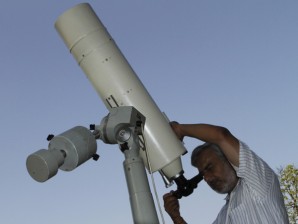
Indian Pramod Kumar Pandey, Director of Jawahar Planetarium checks a telescope as he makes preparations for people to watch the transit of Venus in Allahabad, India, Tuesday, June 5, 2012. Stargazers around the world are setting up special telescopes and passing out cardboard eclipse glasses to view the once-in-a-lifetime celestial cameo of Venus passing in front of the sun. Venus is Earth's second-closest neighboring planet. AP/RAJESH KUMAR SINGH
WASHINGTON – Astronomers around the world trained their telescopes on the skies Tuesday to watch Venus pass in front of the Sun, a once-in-a-lifetime event that will not be seen for another 105 years.
The transit of Venus began shortly after 6:00 pm (2200 GMT) in cloud-free areas of North America, Central America and the northern part of South America, and was visible, with magnification, as a tiny black dot on the solar surface.
Eager skywatchers flocked to universities and observatories that scheduled viewings and astronomy talks for the public, some with sun-safe telescopes and others with large screens for viewing the transit.
A NASA live webcast of the event from Hawaii malfunctioned briefly soon after it began, likely due to heavy Internet traffic.
The nearly seven-hour passage of the planet between the Earth and the Sun should only be viewed through approved solar filters to avoid the risk of blindness, experts warn.
All of the transit will be visible in East Asia and the Western Pacific. Europe, the Middle East and South Asia will get to see the end stages of the eclipse as they go into sunrise on June 6.
Most of South America as well as west and southwest Africa will not get to see it except by broadcasts from other locations.
The US space agency NASA has promised “the best possible views of the event” through high-resolution images taken from its Solar Dynamics Observatory (SDO), in orbit around the Earth.
“A transit is a wonderful and rare sight; when you consider the vastness of the sky, for a planet to pass the disc of the Sun is pretty unusual – and you do have to wait until 2117 for the next one,” said SDO co-investigator Richard Harrison.
The European Space Agency’s Venus Express is the only spacecraft orbiting the hot planet at present and will be using light from the Sun to study Venus’s atmosphere.
ESA and Japan’s space agency also have satellites in low-Earth orbit to observe as Venus passes in front of the Sun.
And the NASA Hubble Space Telescope, which cannot view the Sun directly, will use the Moon as a mirror to capture reflected sunlight and learn more about Venus’s atmosphere.
For the smartphone set, there’s an app for tracking the transit at https://tov2012.esri.com, according to Astronomers Without Borders.
Scientists say that studying the transit will boost future efforts to identify distant planets and learn more about their atmospheres.
Only six transits have ever been observed (in 1639, 1761, 1769, 1874, 1882 and 2004) because the transit is invisible without magnification, though the event has happened 53 times between 2000 BC and 2004. The next will not take place until 2117.
Sunglasses are not strong enough to shield the eyes for viewing the transit, experts say.
Specialized solar filters and glasses will be offered at some observatories, or people can make a pinhole camera or use a pair of binoculars – not held to the eyes – to project the Sun’s image onto a light-colored surface.
Further details:
NASA webcast at https://venustransit.nasa.gov/transitofvenus.
For a list of transit times in US cities: https://eclipse.gsfc.nasa.gov/transit/venus/city12-2.html.
For international locations: https://eclipse.gsfc.nasa.gov/transit/venus/city12-1.html